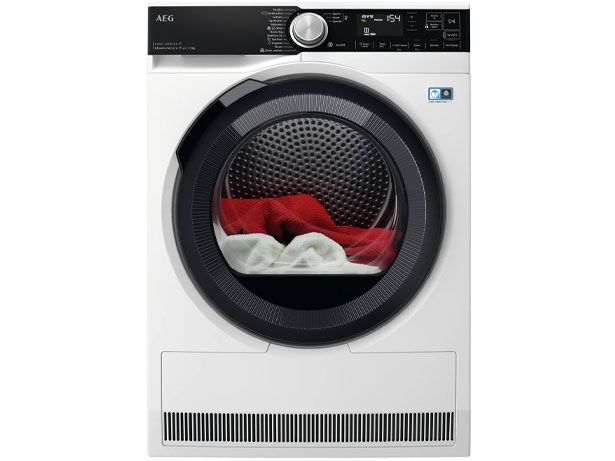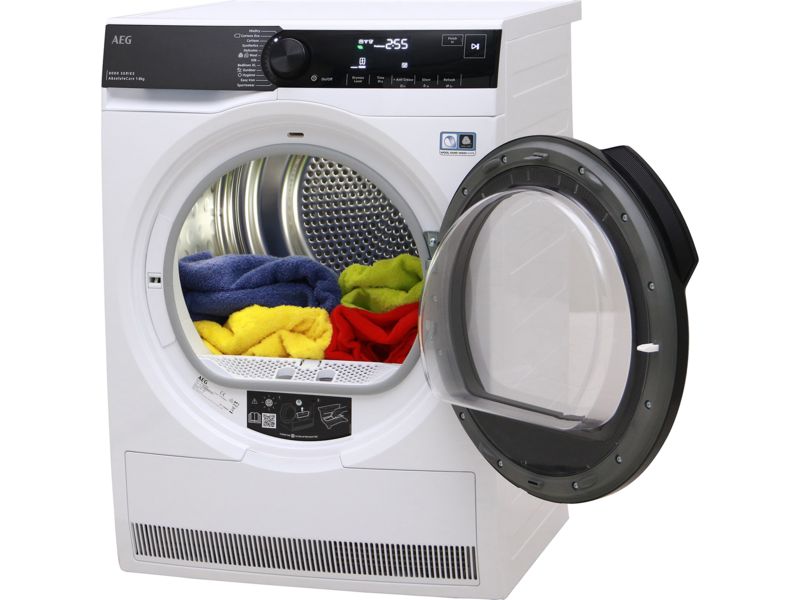Full Access first month £5, then £11.99 per month, cancel at any time
By clicking a retailer link you consent to third-party cookies that track your onward journey. If you make a purchase, Which? will receive an affiliate commission, which supports our mission to be the UK's consumer champion.
Best condenser tumble dryers: Which? Best Buys and expert buying advice

In this article
- Best cheap condenser tumble dryers
- Best mid-range condenser tumble dryers
- Best top of the range condenser tumble dryers
- Top scoring condenser tumble dryer
- What is a condenser tumble dryer?
- How cheap are condenser tumble dryers?
- How much do condenser tumble dryers cost to run?
- How to buy the best condenser tumble dryer
Condenser tumble dryers can be cheap to buy and easy to use, but is a condenser dryer the right choice for your home?
This guide answers all your top condenser tumble dryer questions and shares our top dryer recommendations. You can also see our full list of condenser tumble dryer reviews to compare models.
We've pulled out our top picks below from all the condenser tumble dryers we've tested. While cheap to buy and great at drying clothes quickly, none are Best Buys. That's because all condenser dryers use too much energy to earn our top recommendation.
Not convinced by a condenser tumble dryer? Read our guide to the best tumble dryers on test with expert buying advice on which type to choose.
Best cheap condenser tumble dryers
Only logged-in Which? members can view our recommendations in the table. If you’re not yet a member, you can get instant access by joining Which?.
- Sign up to revealAlready a member?Log in£to run per year
- Sign up to reveal
Full Access first month £5, then £11.99 per month, cancel at any time
Already a member?Log in£to run per year
Best mid-range condenser tumble dryers
- Sign up to reveal
Full Access first month £5, then £11.99 per month, cancel at any time
Already a member?Log in£to run per year - Sign up to reveal
Full Access first month £5, then £11.99 per month, cancel at any time
Already a member?Log in£to run per year
Best top of the range condenser tumble dryers
- Sign up to reveal
- great value
Full Access first month £5, then £11.99 per month, cancel at any time
Already a member?Log in£to run per year
Top scoring condenser tumble dryer
- Sign up to reveal
- great value
Full Access first month £5, then £11.99 per month, cancel at any time
Already a member?Log in£to run per year
Pricing, recommendations and scores correct as of November 2024.
What is a condenser tumble dryer?
All types of tumble dryer share a common purpose: getting your clothes dry. The differences come in how they dispose of the damp air created in the drying process.
Condenser tumble dryers collect water vapour in a container, or it can be drained away, which means the dryers don’t need to be installed near a vent or window, unlike vented tumble dryers.
They tend to be a fairly inexpensive option compared to heat pump tumble dryers, although they’re not as cheap as some vented models.
Most have a humidity sensor to cut off the program at just the right time when your washing is dry, though cheaper condenser dryers use a manual timer.
Condenser dryers usually have quick programs, but they aren’t the most energy efficient option.
How does a condenser tumble dryer work?

Condenser tumble dryers move the hot air created in the drying process into a unit and condense it into water.
The water is collected and stored in a water tank. This needs emptying regularly unless you choose to plumb in your dryer and pump the water out through a hose (as you would do with your washing machine).
Because of this, condenser dryers need an ambient temperature to work effectively. Most manufacturers state that their dryers need to be in a room that never drops below 5°C or goes above 30°C.
Condenser dryers need regular maintenance. You should clean the lint filter which you'll usually find inside the door and empty the water tank each time you do a load. Clean the heat exchanger every few months and wipe down the sensor bars inside the drum if your dryer has them.
The condensing process uses a lot of energy. If you’re after a more efficient machine with lower ongoing costs, you should consider a heat pump tumble dryer.
How cheap are condenser tumble dryers?
Condenser tumble dryers tend to be less expensive to buy than dryers with heat pumps, but not as cheap as vented dryers.
We've found you can get a good condenser dryer for around £300.
How much do condenser tumble dryers cost to run?
Condenser tumble dryers aren't cheap to run, using more than twice the energy that a heat pump dryer needs to do the same job.
The cheapest condenser dryers we've tested cost around £100 to run for a year, the most expensive cost more than £171.
On average, a condenser tumble dryer costs around £127 per year in energy costs and that's £77 more than energy efficient heat pump dryers, which cost around £50 each year.
Tumble dryer type and price
| Vented tumble dryer | Condenser tumble dryer | Heat pump tumble dryer | |
|---|---|---|---|
| Lowest price | £200 | £239 | £349 |
| Average price | £266 | £333 | £730 |
| Highest price | £395 | £713 | £1,499 |
The pricier condenser dryers tend to have more drying features, cheaper machines tend to be more basic. Look out for a child lock to keep your settings from being tampered with, digital displays that countdown to the end of your program, or a light in the drum to help with unloading.
How to buy the best condenser tumble dryer

Our testing proves that a high price doesn’t always guarantee a good condenser tumble dryer. Here are three things you should look for to buy the best for you:
1) Energy use
None of the condenser tumble dryers we’ve tested score highly for energy use. This is because they use more than twice the energy needed by a heat-pump dryer to dry clothes. And they're not alone - vented dryers are equally inefficient.
To find out how much they cost to run per year go to the tech specs tab on our tumble dryer reviews. Our energy calculations are based on each tumble dryer being used three times a week to dry a 70% full load of cottons.
2) Effective condensation unit
We test all condenser and heat pump tumble dryers on how well they keep damp air inside the machine. A dryer that does this well shouldn’t leave your walls damp or, worse, cause mould to grow in the room it’s in.
3) Drying performance
There are huge differences between how well condenser dryers can dry your clothes. The worst will mean you’ll have to hang up your laundry after their spin in the dryer, but the best can dry typically tricky jeans and even manage to get synthetic items dry on a cotton load, great news for those who don’t separate out their laundry before drying.
What's the difference between a condenser and heat pump tumble dryer?
XXX
What's the difference between vented and condenser tumble dryers?
The main difference is how they deal with the damp air from drying. Vented dryers vent the air through a hose. You will have to drill a hole through a wall or place your dryer near a window so the hose can let the air outside.
With condenser dryers you'll need to empty the water container after nearly every cycle (unless you plumb it in).
But because you're not tied to using a hose with a condenser tumble dryer it's easier to site it in your kitchen or utility room.
Vented tumble dryers also tend to be slower at drying than condensers. But the two types of machine tend to use a similar amount of energy to get the job done and they cost about the same to buy.
Can you turn a vented tumble dryer into a condenser?
Technically, you can. Tumble dryer condenser kits are available to buy online from as little as £5 up to around £20. But bear in mind they'll invalidate your warranty.
How do tumble dryer condenser kits work?
Most tumble dryer condenser kits include an exhaust hose (which fits over the steam outlet on your dryer), a condenser unit and a container where the water collects.
You’ll need to put water, or sometimes blocks of ice, in the condenser unit, to keep the temperature down and help the water vapour to condense. You’ll also need to empty the container after each use.
These boxes won’t be nearly as effective or efficient as a proper condenser dryer. They don’t recover heat in the same way, so your dryer will have to use more energy getting your clothes dry, and there’s a risk of damp air leaking out and causing condensation to build up in your kitchen or utility room.
Can you get integrated condenser tumble dryers?
Integrated tumble dryers are a neat solution for a streamlined kitchen, hiding your appliance behind your counters. But you’ll struggle to find an integrated dryer that’s also a condenser.
That's because condenser dryers need ventilation and space around them to work effectively, so they’re not best suited to being boxed into a kitchen unit.
If you’re set on buying one, see our integrated tumble dryer reviews or for more information read our guide to how to buy the best integrated tumble dryer.
Who makes black and silver condenser tumble dryers?
There isn’t a huge choice for those who want to add a colourful twist to their condenser dryer, but we have tested some black, silver and graphite models from LG, Bosch, Samsung, Beko, Haier and Candy.
You don’t necessarily have to splash the cash for an alternative finish. Most black and silver dryers we've tested are similar in price to the white versions.
How to clean a tumble dryer condenser
As well as cleaning the lint filter and emptying the container after each use, you must also undertake another regular maintenance task: cleaning the condenser (or heat exchanger). Here’s how to do it:
- Locate the condenser unit, otherwise known as the heat exchanger. It’s usually on the front of the machine behind a vented panel.
- Make sure your machine is turned off at the mains and has cooled down before you remove the condenser.
- Rinse it in a strong jet of warm water, making sure that all the lint and debris comes off.
- Let it air dry completely before you replace it in the machine.
- Look in your manual for manufacturer guidance on how often to do this. We recommend every few months.
For more tips and tricks on getting the most out of your dryer, see our tumble dryer maintenance guide.
If you're ready to buy a tumble dryer now, take a look at our condenser tumble dryer reviews or all of our tumble dryer reviews.



